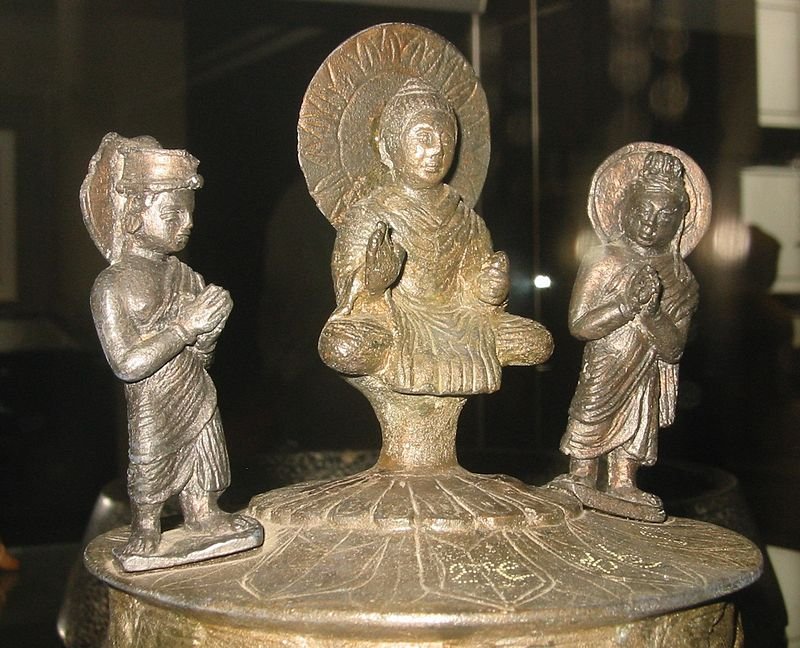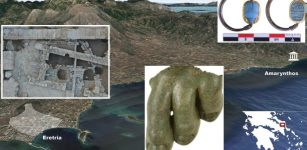Kanishka Casket – Beautiful Ancient Buddhist Treasure In Gilded Copper
A. Sutherland - AncientPages.com - The Kanishka Casket (known as the Kanishka reliquary) is a beautiful Buddhist treasure of gilded copper. The relic dates back to the first year of the reign of the Kushan emperor Kanishka, in 127 AD.
Kanishka casket, Asia, G33 South Asia British Museum, England. Image credit: Anthony Huan - CC BY-SA 2.0
It was discovered in a deposit chamber under the massive Kanishka stupa during British archaeological excavations in 1908 - 1909 in Shah-ji-Dheri on the peripheries of Peshawar, Pakistan. Chinese Buddhist pilgrims described this gigantic structure in the 7th century as the tallest stupa in India. It was indeed an enormous structure.
The stupa is believed to have influenced later constructions of stupas throughout ancient Turkistan. These wooden towers, topped with metal chatras (chhatra (meaning "umbrella"), made such buildings act as lightning rods.
It was probably considered dangerous, so this structure gradually disappeared.
Undoubtedly, the Kanishka stupa is a valuable historical and cultural landmark, but so is the Kanishka Casket, which was unearthed with three small bone fragments of Buddha. The bones were transported to Burma by the British following the excavation, where they are still stored.
In Peshawar, Pakistan, the Kanishka stupa has been described as one of the tallest in the world and has been visited by early Chinese Buddhist pilgrims. One of them was Faxian (337 AD – c. 422 AD), a Chinese Buddhist monk and translator who traveled by foot from China to India, visiting sacred Buddhist sites.
The Kanishka Casket, is the precious the artifact (just over 19 cm in height, with a diameter of 10 cm or more) is now in the Peshawar Museum, and the British Museum has its copy.
Detail of the Buddha, surrounded by cherubs, with devotee or bodhisattva. Image source
The casket is dedicated to the Kharoshthi script, an ancient Indian script used in Gandhara (now Pakistan and north-eastern Afghanistan) to write Gandhari Prakrit and Sanskrit. The script was also used in Central Asia.
The inscription reads:
"In Kanishkapura city, this incense box is the great king Kanishka's monastery's superintendents of construction of the fire hall, Mahasena's and Samgharakshita's, donation.
May it be for the benefit and pleasure of all living beings. In possession of the Sarvastivadin teachers."
Originally it was long believed that the text is signed by a Greek artist named Agesilas, who oversaw work at Kanishka's stupas ('caitya'), confirming the direct involvement of Greeks with Buddhist realizations at such a late date:
"The servant (dasa) Agisalaos, the superintendent of works at the vihara of Kanishka in the monastery of Mahasena" ("dasa agisala nava-karmi ana*kaniskasa vihara mahasenasa sangharame").
However, recent cleaning of the Kanishka Casket revealed that the inscription's old reading was inaccurate. Instead, the name is to be read 'agnisala' (instead of 'Agisalaos') and refers to the monastery, not a person.
 Kanishka Casket - Detail of the Indra, Buddha, Brahman trilogy. Image source
Kanishka Casket - Detail of the Indra, Buddha, Brahman trilogy. Image source
The casket's lid depicts the Buddha on a lotus pedestal and worshipped by Brahma and Indra.
"On the body of the casket, there is a standing figure of a man in Kushana costume and a row of small, active naked figures carrying a garland. In its swags appear other figures, either half-length or composed in the attitude of meditation". 1
The edge of the lid is decorated by a frieze of flying geese, or hamsa, used in Hinduism and Buddhism, as a symbol of protection against the evil eye and the symbol representing the interplay of the body's body chakras, the concept found in the early traditions of Hinduism. The 'hamsa' also means the travel of departing souls and the removal from samsara (the idea of rebirth and "life, matter, existence," all moving in cycles), a fundamental belief of most Indian religions.
The body of the casket represents a Kushan monarch, probably Kanishka in person, with the Iranian Sun god and Moon god at his side. On the sides are two images of a seated Buddha, worshiped by a royal figure, possibly a bodhisattva (one who can reach nirvana but delays doing so through compassion for suffering beings.)
Kanishka (or Kanishka the Great) was an emperor of the Kushan dynasty in the second century (c. 127–150 CE). He is famous and remembered for his military, political, and spiritual achievements. His native language is unknown.
Written by – A. Sutherland - AncientPages.com Senior Staff Writer
Updated on April 11, 2023
Copyright © AncientPages.com All rights reserved. This material may not be published, broadcast, rewritten or redistributed in whole or part without the express written permission of AncientPages.com
Expand for references- Myer, Prudence R. "Again the Kanishka Casket." The Art Bulletin48, no. 3/4 (1966): 396-403
Loeschner Hans, “The Stūpa of the Kushan Emperor Kanishka the Great”
More From Ancient Pages
-
 Norse Shamanism: A Völva And Her Prophecies Were Feared Among Norse Gods And Vikings
Featured Stories | May 19, 2020
Norse Shamanism: A Völva And Her Prophecies Were Feared Among Norse Gods And Vikings
Featured Stories | May 19, 2020 -
 Bronze Age Finding Offer New Clues On The Beginnings Of Cardiff
Archaeology | Jul 15, 2022
Bronze Age Finding Offer New Clues On The Beginnings Of Cardiff
Archaeology | Jul 15, 2022 -
 Crannogs – Artificial Islands In Scotland Are Older Than Stonehenge
Archaeology | Jun 17, 2019
Crannogs – Artificial Islands In Scotland Are Older Than Stonehenge
Archaeology | Jun 17, 2019 -
 On This Day In History: Walpurgis Night Celebration In Northern Europe – On Apr 30
News | Apr 30, 2016
On This Day In History: Walpurgis Night Celebration In Northern Europe – On Apr 30
News | Apr 30, 2016 -
 Enigmatic Voynich Manuscript: Computer Scientists From Alberta Use AI To Decipher Document
Archaeology | Jan 31, 2018
Enigmatic Voynich Manuscript: Computer Scientists From Alberta Use AI To Decipher Document
Archaeology | Jan 31, 2018 -
 New Study Reveals Who Destroyed New York’s First Dinosaur Museum
News | May 29, 2023
New Study Reveals Who Destroyed New York’s First Dinosaur Museum
News | May 29, 2023 -
 Sanctuary Of Amarysia Artemis, Amarynthos – New Valuable Finds By Greek-Swiss Team
Archaeology | Sep 26, 2022
Sanctuary Of Amarysia Artemis, Amarynthos – New Valuable Finds By Greek-Swiss Team
Archaeology | Sep 26, 2022 -
 Ancient Secrets Of Karelia: Mysterious Vottovaara Mountain Was Sacred To The Sami People
Featured Stories | Apr 5, 2017
Ancient Secrets Of Karelia: Mysterious Vottovaara Mountain Was Sacred To The Sami People
Featured Stories | Apr 5, 2017 -
 On This Day In History: National Hero Paul Revere Warns Of The British Coming – On Apr 18, 1775
News | Apr 18, 2017
On This Day In History: National Hero Paul Revere Warns Of The British Coming – On Apr 18, 1775
News | Apr 18, 2017 -
 Elusive Non-Binary Gender In Prehistoric Europe – A Forgotten Minority
Archaeology | May 26, 2023
Elusive Non-Binary Gender In Prehistoric Europe – A Forgotten Minority
Archaeology | May 26, 2023 -
 Dangerous Magnetic Anomaly And Unexplained Events In Mysterious And Dark Valley Trouble Scientists – Why Must The Stone Gate Not Be Crossed?
Featured Stories | Nov 7, 2024
Dangerous Magnetic Anomaly And Unexplained Events In Mysterious And Dark Valley Trouble Scientists – Why Must The Stone Gate Not Be Crossed?
Featured Stories | Nov 7, 2024 -
 Ancient Mystery Of The Strange, Small Underground Being Who Secretly Emptied Casks
Featured Stories | Dec 8, 2024
Ancient Mystery Of The Strange, Small Underground Being Who Secretly Emptied Casks
Featured Stories | Dec 8, 2024 -
 Mysterious Grave Of King Valdemar IV Atterdag – Will The 600-Year-Old Historical Puzzle Ever Be Solved?
Featured Stories | Jul 14, 2018
Mysterious Grave Of King Valdemar IV Atterdag – Will The 600-Year-Old Historical Puzzle Ever Be Solved?
Featured Stories | Jul 14, 2018 -
 Oldest Human Remains Unearthed In Vietnam
Archaeology | Nov 15, 2023
Oldest Human Remains Unearthed In Vietnam
Archaeology | Nov 15, 2023 -
 Incredible Trove Of 100,000 Ancient Coins Tied Together In Bundles Uncovered In Japan
Archaeology | Nov 13, 2023
Incredible Trove Of 100,000 Ancient Coins Tied Together In Bundles Uncovered In Japan
Archaeology | Nov 13, 2023 -
 6,000 Years Ago, Europe’s Oldest Cities Relied On Fertilizer And Plant Protein, Isotope – Analysis Shows
Archaeology | Dec 19, 2023
6,000 Years Ago, Europe’s Oldest Cities Relied On Fertilizer And Plant Protein, Isotope – Analysis Shows
Archaeology | Dec 19, 2023 -
 Excavations of the Aşıklı Mound, Cappadocia , Turkey
Civilizations | Aug 22, 2015
Excavations of the Aşıklı Mound, Cappadocia , Turkey
Civilizations | Aug 22, 2015 -
 Underground Hellenistic Necropolis With Tombs With Frescoes, Reliefs Unearthed In Naples, Italy
Archaeology | May 13, 2023
Underground Hellenistic Necropolis With Tombs With Frescoes, Reliefs Unearthed In Naples, Italy
Archaeology | May 13, 2023 -
 Shangshan Culture Drank Ancient Rice Beer 10,000 Years Ago – Archaeological Evidence Found In China
Archaeology | Dec 13, 2024
Shangshan Culture Drank Ancient Rice Beer 10,000 Years Ago – Archaeological Evidence Found In China
Archaeology | Dec 13, 2024 -
 Merovingian Dynasty Of Long Haired Kings
Featured Stories | Jan 18, 2019
Merovingian Dynasty Of Long Haired Kings
Featured Stories | Jan 18, 2019


